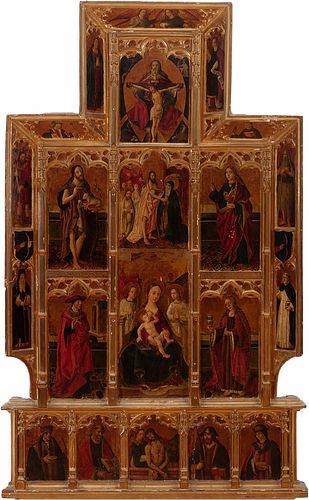Valencian school. Group of the Master of Perea, late fifteenth century. Altarpiece of the Virgin of the Milk. Tempera on panel.
Lot 80
About Seller
Setdart Auction House
Carrer Aragó 346
Barcelona
Spain
Setdart Subastas was born in 2004 and is currently the first online art auction in Spain with solidity, prestige and reliability guaranteed by our more than 60,000 users. Setdart has a young, dynamic and enterprising team ready to successfully manage the purchase and sale of art works through custom...Read more
Estimate:
EUR€80,000 - EUR€100,000
$86,021.51 - $107,526.88
Absentee vs Live bid
Two ways to bid:
- Leave a max absentee bid and the platform will bid on your behalf up to your maximum bid during the live auction.
- Bid live during the auction and your bids will be submitted real-time to the auctioneer.
Bid Increments
| Price | Bid Increment |
|---|---|
| EUR€0 | EUR€10 |
| EUR€200 | EUR€25 |
| EUR€500 | EUR€50 |
| EUR€1,000 | EUR€100 |
| EUR€3,000 | EUR€200 |
| EUR€5,000 | EUR€500 |
| EUR€10,000 | EUR€1,000 |
| EUR€20,000 | EUR€2,000 |
| EUR€50,000 | EUR€5,000 |
About Auction
By Setdart Auction House
Oct 20, 2021
Set Reminder
2021-10-20 07:30:00
2021-10-20 07:30:00
America/New_York
Bidsquare
Bidsquare : OLD MASTERS
https://www.bidsquare.com/auctions/setdart-auction-house/old-masters-7700
Setdart Auction House sofia@setdart.com
Setdart Auction House sofia@setdart.com
- Lot Description
Valencian school. Group of the Master of Perea, late fifteenth century. Altarpiece of the Virgin of the Milk. Tempera on panel. Presents old restorations. Provenance: collection of the Counts of Alcubierre. We are grateful to Dr. David Gimilio, curator of the Museum of Fine Arts of Valencia, for his contribution to the cataloguing. Measurements: 180 x 107 x 12 cm. Important devotional altarpiece, probably commissioned for a private oratory by a family whose coat of arms is represented on the sides. Dedicated to the Virgin of the Milk, it is a representative piece of late Gothic Valencian painting, of great interest both for its quality and its good state of preservation, with none of its panels missing. It presents a typology common to the late Gothic altarpieces, as can be seen in the Museum of Fine Arts of Valencia. Thus, we are faced with an altarpiece divided into three sections with a second body over the central panel, in addition to the predella, all of which are divided by architectural elements typical of the period (lobed tracery, pinnacles) and with an openwork form based on stems ending in arches. Iconographically, the altarpiece is dedicated to the Virgin of the Milk, represented in its central panel, and forming in vertical line a thematic continuity that shows the apparition of Christ to Mary, Christ the Man of Sorrows in the predella and, in a mandorla of the attic, the Eternal Father holding the crucified Christ. In the side streets, we can distinguish the saints Jerome, John the Baptist and Evangelist, and Mary Magdalene. In the predella, Christ is flanked by St. Peter, St. James the Greater, and Cosmas and Damian. This last one traditionally has great devotion in Valencia. In the polseras, also complete, are represented the scene of the Annunciation, San Antonio Abad, San Cristobal and San Onofre, with their respective attributes. Stylistically, there are formal solutions that place the piece in a phase of late-medieval transition towards the Renaissance. Thus, the backgrounds cease to be gilded to introduce an incipient perspective through the tesserae of the floors and furniture. Likewise, the figures acquire volume, physically occupying the space. However, the nimbuses, the mandorlas and the anatomical stylization, as well as the idealized and synthetic characterization of the faces, are aspects still linked to the Gothic style. The naturalistic work of the drapery, and above all the capture of the right qualities of the fabrics, denotes the Flemish influence. The Flemish imprint is especially noticeable in the central panel, in the borders of the Marian mantle, in the vivacity of the child's face and, in iconographic terms, in the importation of the Flemish model of the typology of the Virgin of the Milk popularized by Rogier van der Weyden. Fernando Benito, director of the Museum of Valencia, confirms the attribution of this altarpiece to the Perea Master Group. Given that the organization of the painting workshops at that time was usually directed by a master with whom several artists specialized in gilding, carvings, pigments, etc. collaborated.... often the name of the master is not known (as is the case with Perea, Borbotó, Xátiva, Artés...). However, in the catalog of the exhibition "La memoria recobrada", when studying the panel of the prophet Jeremiah from the main altarpiece of Denia, the possibility is noted, with all the necessary reservations, of identifying the Master of Peresa with Martí Girbes, painter of the king and of the City of Valencia, who completed and collected part of that altarpiece left unfinished by Joran Rixach. The Virgin of the Milk, also known as the nourishing Virgin or wet nurse, of the Rest or Bethlehem, is a Marian iconography in which Mary is represented breastfeeding the Child. It is based on the story of the Grotto of the Milk, in Bethlehem, where tradition says that the Virgin gave suckling to the Child, and a drop spilled on a rock, which changed its color, becoming white. Because of this, stones from the grotto were considered relics in the early centuries because, when diluted in water, it took on the appearance of milk. The sanctuary erected in this place is used by women who ask the Virgin to improve the quality of their mother's milk.
- Shipping Info
-
In-house shipping available. Please inquire at admin@setdart.com.
-
- Buyer's Premium



 EUR
EUR CAD
CAD AUD
AUD GBP
GBP MXN
MXN HKD
HKD CNY
CNY MYR
MYR SEK
SEK SGD
SGD CHF
CHF THB
THB









